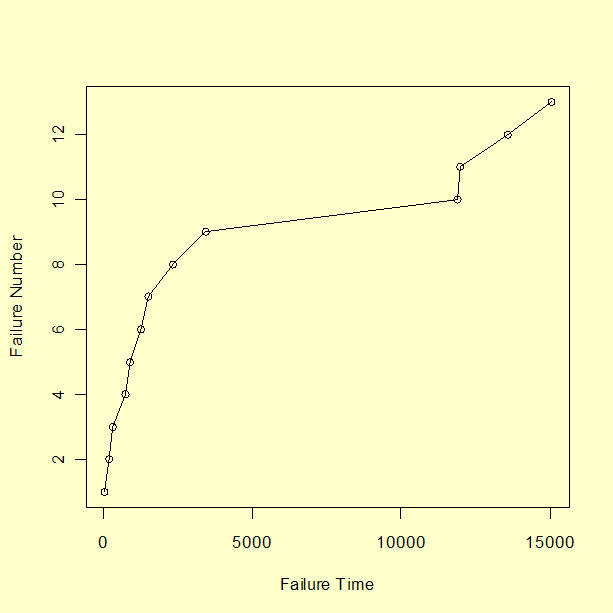8.1. Introduction
8.1.9. How can you model reliability growth?
8.1.9.1. |
NHPP power law |
In terms of the original parameters for \(M(t)\), we have $$ a = \frac{\alpha}{1-\beta}\,\,\, \mbox{ and } \,\,\, b = 1-\beta \,\, . $$ Use of the Power Law model for reliability growth test data generally assumes the following:
1. While the test is ongoing, system improvements are introduced that produce continual improvements in the rate of system repair.
2. Over a long enough period of time the effect of these improvements can be modeled adequately by the continuous polynomial repair rate improvement model \(\alpha t^{-\beta}\).
Assumption three means that when the test ends, the HPP constant repair
rate model takes over and the MTBF for the system from then on is the reciprocal
of the final repair rate or \((T^{\beta})/\alpha\).
If we estimate the expected number of failures up to time T by the actual
number observed, the estimated MTBF at the end of a reliability test (following
the Power Law) is:
$$ \mbox{ESTIMATED MTBF AT END OF TEST } = \frac{T}{r(1-\beta)} \,\, , $$
with \(T\) denoting the test time,\(r\)
is the total number of test failures and \(\beta\)
is the reliability growth slope. A formula for estimating \(\beta\)
from system failure times is given in the
Analysis Section for the Power Law model.
Step 1: User inputs the positive constants \(a\) and \(b\).
Step 2: Simulate a vector of \(n\) uniform (0,1) random numbers. Call these \(U_1, \, U_2, \, U_3, \, \ldots, \, U_n\).
Step 3: Calculate \(Y_1 = \left\{ -\frac{1}{a} \mbox{ ln } U_1 \right\}^{1/b}\).
Step \(i\): Calculate \(Y_i = \left\{ Y_{i-1}^b - \frac{1}{a} \mbox{ ln } U_i \right\}^{1/b} \) for \(i\) = 2, ..., \(n\).
The \(n\) numbers \(Y_1, \, Y_2, \, \ldots, \, Y_n\) are the desired repair times simulated from an NHPP Power Law process with parameters \(a, \, b\) (or \(\beta = 1-b\) and \(\alpha = ab\)).
We generated \(n\) = 13 random repair times using the NHPP Power Law process with \(a\) = 0.2 and \(b\) = 0.4. The resulting data and a plot of failure number versus repair times are shown below.
| Failure | Failure |
| Number | Time |
| 1 | 26 |
| 2 | 182 |
| 3 | 321 |
| 4 | 728 |
| 5 | 896 |
| 6 | 1268 |
| 7 | 1507 |
| 8 | 2325 |
| 9 | 3427 |
| 10 | 11871 |
| 11 | 11978 |
| 12 | 13562 |
| 13 | 15053 |
 The NHPP power law process can be implemented using both
Dataplot code and R code.
The NHPP power law process can be implemented using both
Dataplot code and R code.

